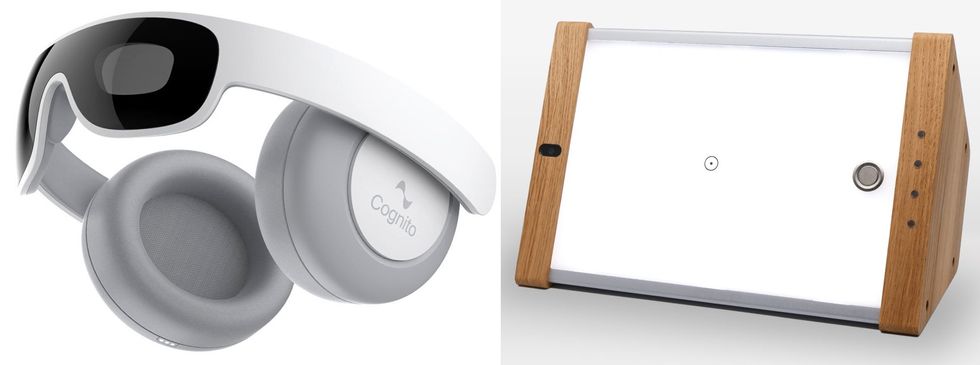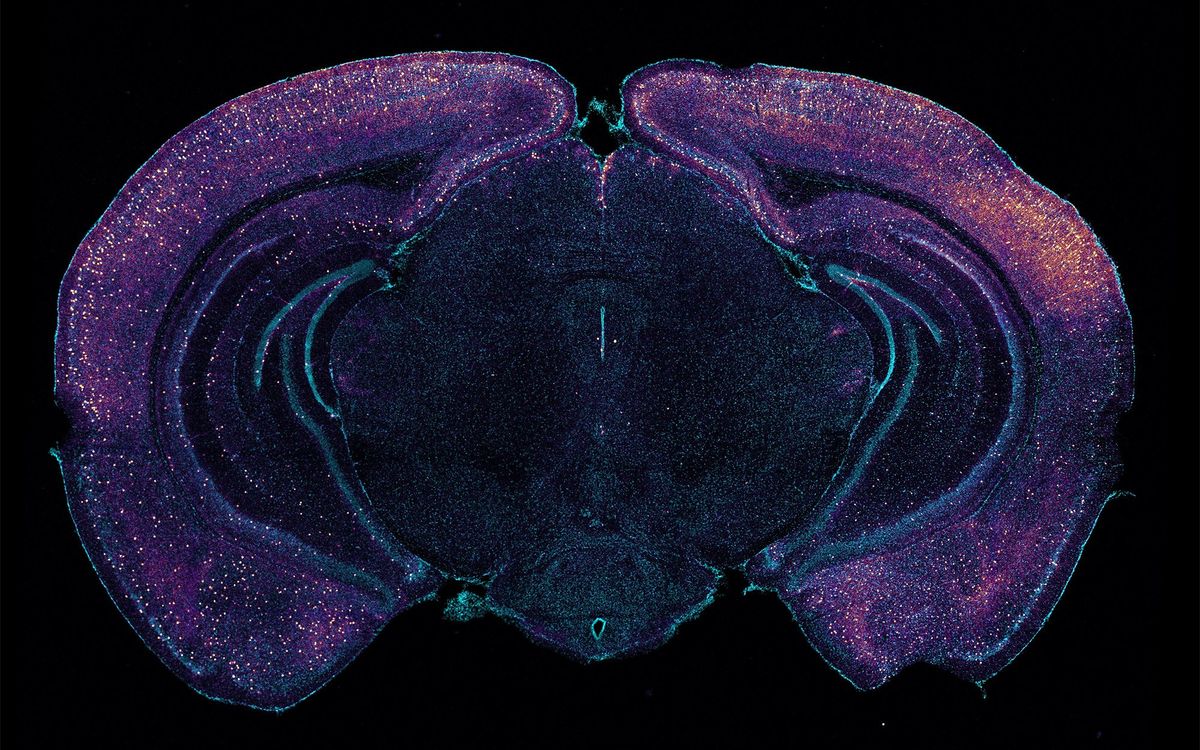A flicker of light and a buzz of sound may hold the key to combating Alzheimer’s disease—and a new study in mice offers insights into how this unconventional therapy might work in humans.
The noninvasive brain-stimulation technology features an audiovisual disco of rhythmic 40-hertz stimuli, designed to boost brain health by enhancing neural activity at the same “gamma” frequency.
Administered for an hour each day through an integrated headset or display panel, the at-home therapy has shown promise in early clinical testing. In people with various stages of Alzheimer’s, it has been associated with preserved brain volume, strengthened connectivity between neurons, improved mental functioning, and more restful sleep, among other benefits.
A medical device startup called Cognito Therapeutics is currently evaluating the sensory therapy in a large randomized trial of people with mild-to-moderate Alzheimer’s. Meanwhile, the company’s academic cofounders—neuroscientist Li-Huei Tsai and neuroengineer Ed Boyden, both at the Massachusetts Institute of Technology (MIT)—continue to stress how the 40-Hz sync sessions induce beneficial changes in mouse models.

In their latest paper, the MIT researchers found that this rhythmic remedy aids in the removal of beta-amyloid, the sticky protein that clumps together in the brains of those with Alzheimer’s disease. And it does so through a neural-cleansing process known as glymphatic clearance.
How does 40-Hz therapy work?
The 40-Hz therapy helps to bring more cerebrospinal fluid (CSF) into the brain. The neural juices then slosh around, accumulate beta-amyloid gunk, and flow out through specialized waste-removal channels before eventually getting eliminated through the body’s excretory pathways.
“It’s so important to understand how this works,” says Tsai, director of MIT’s Picower Institute for Learning and Memory. “It really makes the therapy that much more compelling.”
But not everyone is waiting for these kinds of mechanistic insights, let alone definitive clinical data, before jumping on the 40-Hz bandwagon.
Indeed, some companies have already begun offering consumer-oriented devices and tablet apps that deliver gamma frequency stimulation via light or sound. Marketed for “general wellness,” products such as the EVY Light—a $2,000 light box from OptoCeutics that emits a subtle, nearly imperceptible 40-Hz flicker, designed to be easier on the eyes than the intense strobe lights from other products—are geared toward people worried about potential cognitive decline. But these technologies are also not approved to treat or prevent any neurodegenerative condition.
Before making its device available for purchase, OptoCeutics did run small trials to ensure that the product was safe and produced synchronized brain rhythms in people. A randomized follow-up trial is ongoing in Denmark to see if the therapy can ameliorate various aspects of Alzheimer’s.
But trial results could take years to materialize. Full regulatory approval could take even longer. “And if we really, truly want to know how this technology is going to impact people’s lives, we have to test it out in the real world,” says OptoCeutics cofounder and CEO Mai Nguyen.
Given the minimal risk involved in using this technology, she says, the company opted to make the device available today. “The pros outweigh the cons at the moment,” Nguyen says.
The OptoCeutics platform, like every 40-Hz therapy available or in development today, traces its inspiration back to a landmark 2016 study from Tsai and her MIT team. In that work, the researchers showed how flickering white light at a 40-Hz frequency could help to synchronize neural waves in key brain areas involved in reasoning, planning, and memory.
In so doing, the therapy reduced the buildup of beta-amyloid plaques and tau tangles—hallmark features of Alzheimer’s—in the brains of mice engineered to mimic the condition.
What could 40-Hz therapy do?
This and subsequent studies from the MIT group found that both visual and auditory stimuli at 40 Hz could promote a healthier state in mouse neurons, reversing some aspects of degeneration. Additionally, this sensory experience helped to lessen inflammation caused by microglia, the brain’s immune cells.
And now, reporting in Nature, the researchers have implicated the brain’s glymphatic system in mediating the treatment’s beta-amyloid-lowering effects. What’s more, they pinpointed a key peptide-signaling molecule that neurons use to regulate CSF movement and drive glymphatic clearance.
An independent study, also published today in Nature, by neuroimmunologist Jonathan Kipnis and his colleagues at Washington University further detail how rhythmic neuronal activity of the kind induced by the 40-Hz therapy is critical to fluid perfusion and self-cleaning in the brain.
“The results are very convincing,” says Andrey Vyshedskiy, a neuroscientist at Boston University and one of the creators of AlzLife, an app that delivers gamma-frequency stimulation alongside cognitive-training exercises. Together, Vyshedskiy says, the “animal studies create a scientific foundation and a better understanding of what is changing in the brain.”
If clinical trials confirm the ability of 40-Hz stimuli to clear plaques, maintain brain structure, and slow down dementia, the therapy could emerge as an affordable and user-friendly approach to managing Alzheimer’s—especially when compared to the alternative, monoclonal antibody treatments. These amyloid-targeting drugs are not only expensive, costing tens of thousands of dollars each year, but they also pose risks of causing swelling and bleeding in the brain.
“This may be a preferred option for Alzheimer’s treatment,” says Cognito’s chief medical officer Ralph Kern. Results from the company’s pivotal trial are expected some time next year.
Cognito’s device, known as Spectris, pairs opaque glasses with built-in, flashing LEDs, plus a set of headphones. A possible drawback of this design is the necessity for users to remain stationary during treatment sessions, devoid of any external entertainment or distractions. Some might find this difficult. However, feasibility tests have shown it to be a manageable challenge, with more than 85 percent of participants consistently using the device daily throughout a six-month study.
“Maybe it’s counterintuitive,” Kern says, “but there’s something very attractive about sitting calmly for an hour and having a treatment at home. And we find that people generally are comfortable doing that.”
In addition to its Alzheimer’s study, Cognito plans to begin testing its device on people living with Parkinson’s disease and multiple sclerosis. And Annabelle Singer, a Georgia Tech neurobiologist who serves on the company’s scientific advisory board, expects the therapy to prove beneficial against other conditions, too.
Consider treatment-resistant epilepsy. In a small group of patients being evaluated for potential brain surgery, Singer and her colleagues found that 40-Hz sensory therapy could reduce the incidence of abnormal brainwave events that are indicative of a heightened propensity for seizures.
Autism, schizophrenia, stroke—any number of other brain disorders could potentially be remedied by leveraging gamma frequencies to promote synchronized neuronal activity.
“It certainly is having a beneficial activity on pathological activity that is known to affect cognition,” Singer says. “That’s indicative that this could be useful in a variety of contexts where that matters.”
Elie Dolgin is a science writer specializing in biomedical research and drug discovery. After a PhD spent studying the population genetics of nematodes, he swapped worms for words—entering journalism as an editor at The Scientist, Nature Medicine, and STAT. Now a freelancer, Elie is a frequent contributor to New Scientist, Nature, IEEE Spectrum, and more.



